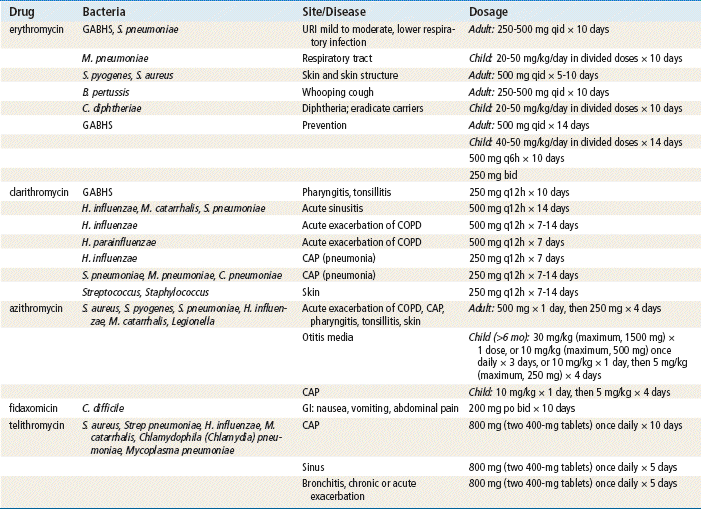http://evolve.elsevier.com/Edmunds/NP/
Erythromycin, azithromycin, and clarithromycin are commonly used in primary care. They have primary indications and are used as an alternative to penicillin in sensitive patients. Erythromycin was derived from Saccharopolyspora erythraea (originally Streptomyces erythreus), found in the Philippines in 1952. Erythromycin is active against most pneumococci and group A β-hemolytic streptoccoci. It is also useful for atypical infections such as Legionella pneumophila, Mycoplasma pneumoniae, Corynebacterium diphtheriae, Chlamydia trachomatis, Listeria monocytogenes, Ureaplasma urealyticum, and some rickettsia. Susceptible gram-negative bacteria include Bordetella pertussis, Neisseria gonorrhoeae, and meningitis. The ketolide telithromycin was approved in 2004. A new drug, fidaxomicin (Dificid), entered the market in late 2011. It is indicated for Clostridium difficile diarrhea. A major limitation to erythromycin use is the frequent occurrence of GI side effects and drug interactions. However, azithromycin and clarithromycin rarely cause problematic GI side effects. Macrolides affect the cytochrome P450 3A4 system, thereby inhibiting the metabolism of certain drugs. A careful patient history of concurrent medications will aid in preventing adverse drug interactions.
Allergy
Reactions include skin rash, fever, and eosinophilia. Cholestatic hepatitis, which occurs rarely, most often with the estolate compound, may be an allergic reaction to the estolate.
Resistance
As macrolide use has increased, macrolide resistance also has increased. Three major mechanisms of resistance to the macrolides have been identified. The most common one is decreased permeability of the cell wall to macrolides. Some bacteria are able to pump the antibiotic out. The second mechanism, target site alterations, results from a genetic ability to decrease binding of the antibiotic to targets on the ribosome. Decreased binding confers a high degree of resistance. The third major mechanism is drug inactivation by enzymes. Use of macrolides increases the nasopharyngeal presence of macrolide and penicillin-resistant pneumococci. Macrolide-resistant Streptococcus is a problem in the treatment of community-acquired pneumonia and middle ear infections. About half of patients with macrolide-resistant infections had not taken antibiotics in the past 6 months. Group A strep resistance is increasing to up to 15% to 35% in some geographic areas. Streptococcus pyogenes, Staphlococcus aureus, Streptococcus viridans, Clostridium perfringens, and Haemophilus influenzae are developing increased resistance to macrolides.
Mechanism of Action
Macrolides consist of a large lactone ring to which sugars are attached. Structural modifications in clarithromycin and azithromycin make them more acid stable, improve tissue penetration, and broaden the spectrum.
Macrolides may be bacteriostatic or bactericidal. The mechanism of action involves inhibition of protein synthesis that results from binding specifically to the 50S ribosomal subunit. This causes the RNA to dissociate from the ribosome and prevents protein synthesis. Macrolides inhibit a specific step in protein synthesis whereby the new tRNA moves from the ribosome to the new site. Telithromycin blocks protein synthesis by binding to a specific location of the RNA on the 50S ribosome.
Other effects of the macrolides occur as gastrointestinal stimulation; they also appear to modulate inflammation by inhibiting production of the cytokine interleukin-8. In addition, macrolides may be used as prokinetic agents in hospitalized patients.
Treatment Principles
Most practitioners consider the macrolides to be a safe first-line choice for patients with uncomplicated infection. Erythromycin products are relatively inexpensive; however, the newer macrolides are more expensive. When a macrolide is prescribed, caution should be taken with dosing in the presence of severe renal or hepatic impairment or when potential drug interactions with the patient’s current drug regimen are identified.
Erythromycin is a first-choice drug for the treatment of children with pneumonia (ages 3 months to 5 years) or ophthalmia neonatorum. Erythromycin is an alternative treatment for impetigo, cellulitis, otitis media, pharyngitis, chlamydia, and Lyme disease. Erythromycin also provides alternative treatment for the prevention of bacterial endocarditis in patients allergic to penicillin. Azithromycin is another first-choice drug for the treatment of pneumonia in children (ages 6 months to 5 years and older). Azithromycin also is a first-choice drug for the treatment of chlamydia in adults and is used alternative treatment for patients with impetigo, cellulitis, sinusitis, pharyngitis, acute exacerbations of COPD, and traveler’s diarrhea. Clarithromycin is used in adults for pharyngitis, sinusitis, otitis media, acute exacerbation of COPD, pneumonia, and skin infection.
The major differences between erythromycin and the newer macrolides include GI tolerability, a broader spectrum of activity, and dosing frequency. Erythromycins must be taken three or four times a day. Azithromycin offers the advantage of once-daily dosing. Clarithromycin requires twice-daily dosing. The longer drug action of azithromycin can make a critical difference in patient adherence.
The strength of each erythromycin product is expressed as erythromycin base equivalents. As a result of differences in absorption and biotransformation, varying quantities of each erythromycin salt form are required to produce the same free erythromycin serum levels. Erythromycin base is acid labile and usually is formulated in enteric- or film-coated forms for oral administration. Acid-stable salts and esters (e.g., estolate, ethylsuccinate, and stearate) are well absorbed.
The macrolides are active primarily against gram-positive organisms, including S. pyogenes (GABHS) and Streptococcus pneumoniae. The newer macrolides have added effectiveness against gram-negative bacteria and anaerobes. Macrolides are of value for their unique ability to treat atypical pathogens such as M. pneumoniae, which are seen in community-acquired pneumonias.
Azithromycin and clarithromycin have significantly increased potency against gram-negative bacteria and anaerobes and generally are reserved for more complicated infections such as community-acquired pneumonia, exacerbation of COPD, and sinusitis.
Fidaxomicin is not appropriate for systemic infection. It has a similar safety profile to vancomycin with a higher response rate after a 10-day course of treatment.
How to Monitor
When used long term, monitoring of hepatic function is prudent, especially for erythromycin estolate.
Patient Variables
Lower doses of macrolides generally are not necessary in the elderly, provided they do not have severe renal or hepatic impairment. Fidaxomicin does not require renal or hepatic dose adjustments because of its minimal systemic absorption.
Check renal and hepatic function before beginning treatment with the drug.
Stay updated, free articles. Join our Telegram channel

Full access? Get Clinical Tree



 Key drug.
Key drug.
